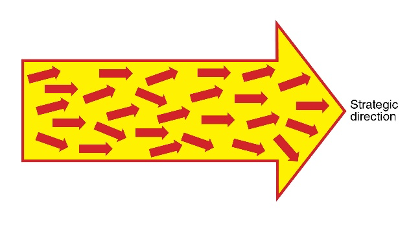Your cart is currently empty!
3 ways KPIs can transform your business
By David Parmenter

Here are three ways that can help you transform your business.
- A clarity of purpose from aligning the Staffs’ daily actions to the organization’s Critical Success Factors. Before measures are developed, you need to know what is important in the organization to get right day in, day out. Every organization on planet earth, seeking outstanding performance, needs to know what its critical success factors are and have these communicated to staff. If the CSFs of the organization are clarified and communicated, staff members will be able to align their daily activities closer to the strategic direction of the organization, as shown in Exhibit 1.Exhibit 1: Achieving a better alignment of effort.

- This behavioural alignment is often the missing link between good and great organizations. CSFs and their associated KPIs are the only things that truly link day-to-day performance in the workplace to the organization’s strategy. In the past people thought that because monthly budgets were linked to the annual planning process, which in turn was linked to the five-year plan, which in turn was linked to the strategic plan, strategy was linked to day-to-day activities. It looked good on paper but never worked in practice.
- Improving Performance through Having Fewer and More Meaningful Measures. Performance measures can and should have a profound impact on performance because they:
- Tend to make things happen; it helps people see progress and motivates action.
- Increase visibility of a more balanced performance and focus attention on what matters.
- Increase objectivity—Dean Spitzer3 points out that staff actually like measuring and even like being measured, but they do not like being judged subjectively.
- Improve your understanding, your decision making, and execution— Spitzer illustrates that you will not be able to execute well, consistently, without measurement. Measurement can improve your business intuition and significantly increase your “decision-making batting average.”
- Improve consistency of performance over the long term.
- Facilitate feedback on how things are going, thereby providing early warning signals to management.
- Help the organization become future-ready by encouraging timely feedback, looking forward by measuring future events (e.g., a CEO should look weekly at the list of celebrations, or recognitions, scheduled for the next two weeks), encouraging innovation, abandonment of the broken, and supporting winning management habits such as recognition, training, and mentoring.
- Creating Wider Ownership, Empowerment, and Fulfilment in All Levels of the Organization
Performance measures communicate what needs to be done and help staff understand what is required. They enable leaders to give the general direction and let the staff make the daily decisions to ensure progress is made appropriately. This shift to training and trusting staff to make the right calls is very much the Toyota way. Any incorrect decision is seen as a fault in training rather than with the individual.
The delegation of authority to the front line is one of the main foundation stones of this KPI methodology (see Chapter 3, Background to the Winning KPI Methodology). This issue was discussed at great length in Jeremy Hope’s book The Leader’s Dilemma.*
I have yet to meet a person who desires failure or finds failure rewarding. Where measures are appropriately set, staff will be motivated to succeed.
* Jeremy Hope, The Leader’s Dilemma: How to Build an Empowered and Adaptive Organization without Losing Control (San Francisco: Jossey-Bass, 2011).
Purchase my latest implementation guides which are currently on sale:
How to implement winning KPIs (180 page Whitepaper + electronic templates)
and buy the Database of Measures and Associated Success Factors 4th Edition